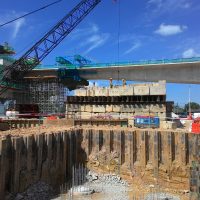Legal Requirements for Shoring and Sheeting During Excavation

Excavation work is a routine part of underground storage tank (UST) installation, removal, and servicing. However, digging below the surface introduces serious safety risks, especially when trenches or pits are deep or the surrounding soil is unstable. To protect workers and prevent cave-ins, regulatory agencies have established strict legal requirements regarding shoring, sheeting, and other protective systems during excavation.
At Herbert Lutz & Company, safety is our top priority on every UST project we handle as an experienced New Jersey and Florida sheeting & shoring contractor. In this post, we’ll explain why shoring and sheeting are critical, outline the key legal requirements that govern these protective measures, and highlight how professional compliance can make excavation work safer and more efficient.
Why Shoring and Sheeting Matter
Excavations are inherently dangerous because soil can shift or collapse with little warning. According to the Occupational Safety and Health Administration (OSHA), one cubic yard of soil can weigh as much as 3,000 pounds—the equivalent of a small car. Even a minor cave-in can be catastrophic, causing serious injuries or fatalities within seconds.
Shoring and sheeting are two of the most effective ways to protect workers and maintain excavation site stability:
- Shoring involves using mechanical supports such as hydraulic jacks, timber, or aluminum beams to prevent soil movement and collapse.
- Sheeting refers to using solid panels, usually made of steel or other durable materials, to support trench walls and hold back soil.
When properly designed and installed, these systems reduce the risk of cave-ins and ensure that excavation sites remain safe for workers, equipment, and surrounding structures.
OSHA Excavation Standards
The primary legal authority governing excavation safety in the United States is OSHA’s Standard 29 CFR Part 1926, Subpart P—commonly known as the Excavation Standard. This regulation applies to all open excavations made in the earth’s surface, including trenches used for UST installation and removal.
Under OSHA’s rules, employers must protect employees working in excavations five feet deep or greater unless the excavation is made entirely in stable rock. Protection can include sloping, benching, shoring, or shielding (such as trench boxes).
For trenches deeper than 20 feet, the protective system must be designed by a registered professional engineer or be based on tabulated data approved by a professional engineer.
OSHA’s excavation standard requires that:
- All protective systems, including shoring and sheeting, must be installed according to the manufacturer’s specifications or engineering designs.
- Daily inspections of excavations, protective systems, and adjacent areas must be conducted by a competent person.
- Workers must have safe access and egress to trenches, typically within 25 feet of lateral travel.
Failure to comply with these rules can result in serious citations, project shutdowns, and steep penalties.
State and Local Regulations
In addition to federal OSHA standards, many states, including New Jersey and Florida, have adopted their own workplace safety programs, which may supplement or mirror federal regulations. For example, New Jersey operates under a federally approved OSHA plan, meaning the state enforces federal safety rules directly.
Florida, while covered by federal OSHA, may have additional environmental permitting requirements tied to excavation, especially when groundwater or protected soil layers are impacted. Local municipalities and counties may also impose stricter requirements, particularly in congested urban areas or regions with known soil stability concerns.
It’s critical to review state, county, and municipal codes before beginning any excavation project to ensure all applicable safety and permitting obligations are met. Working with an experienced local contractor can help ensure compliance.
Responsibilities of the Competent Person
OSHA requires that a “competent person” be present on site whenever workers are exposed to excavation hazards. This person must be capable of identifying existing and predictable hazards, soil types, and signs of potential cave-ins. They must also have the authority to take immediate corrective action, which can include halting work or modifying protective systems.
The competent person must:
- Classify the soil correctly to determine the appropriate type of protective system.
- Inspect the excavation site at least daily and after events that could increase risk, such as heavy rainfall.
- Ensure that shoring, sheeting, and other safety measures are properly installed and functioning.
Without a qualified competent person on site, an excavation project is not legally compliant; more importantly, it is not safe.
Shoring and Sheeting Best Practices
While the legal requirements provide a minimum safety standard, excavation safety should go beyond simple compliance. At Herbert Lutz & Company, we follow industry best practices to ensure every excavation is performed with maximum attention to safety and efficiency.
These best practices include:
- Using engineered shoring and sheeting systems specifically designed for the depth and soil conditions of each project.
- Verifying that all equipment is in good working order and correctly installed.
- Continuously monitoring the excavation environment for changes that could affect stability, such as water seepage or ground vibrations from nearby traffic.
- Coordinating with local utilities to avoid underground service disruptions and added hazards.
Partner with a Trusted UST Contractor
Shoring and sheeting aren’t just regulatory checkboxes—they’re essential safety measures that protect workers, the environment, and project timelines. When excavation work is handled correctly, projects proceed more smoothly, regulatory inspections are passed without issue, and costly delays are avoided.
Herbert Lutz & Company is proud to provide expert UST installation, removal, and servicing with a firm commitment to excavation safety. Additionally, we provide sheeting and shoring services for all types of excavation work in New Jersey and Florida. Our team is fully trained on OSHA excavation standards, and we always provide the qualified personnel, protective systems, and documentation necessary to meet legal requirements on every job site.
If you’re planning a UST installation or any project that involves excavation in New Jersey or Florida, contact Herbert Lutz & Company today. We can walk you through the safety protocols, regulatory steps, and best practices that will keep your project compliant and on schedule from start to finish.
